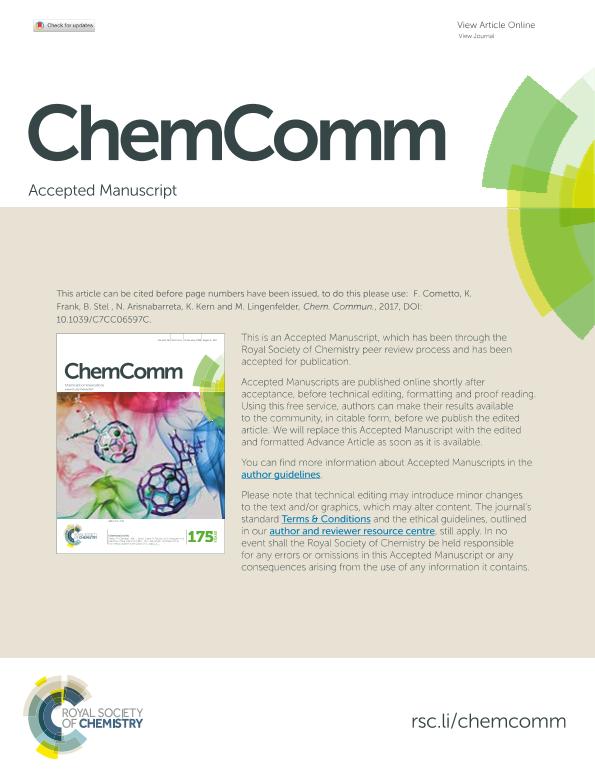Mostrar el registro sencillo del ítem
dc.contributor.author
Cometto, Fernando Pablo

dc.contributor.author
Frank, K.
dc.contributor.author
Stel, B.
dc.contributor.author
Arisnabarreta, Nicolás

dc.contributor.author
Kern, K.
dc.contributor.author
Lingenfelder, Magalí Alejandra

dc.date.available
2018-11-13T18:07:52Z
dc.date.issued
2017-09
dc.identifier.citation
Cometto, Fernando Pablo; Frank, K.; Stel, B.; Arisnabarreta, Nicolás; Kern, K.; et al.; The STM bias voltage-dependent polymorphism of a binary supramolecular network; Royal Society of Chemistry; Chemical Communications; 53; 83; 9-2017; 11430-11432
dc.identifier.issn
1359-7345
dc.identifier.uri
http://hdl.handle.net/11336/64345
dc.description.abstract
A Scanning Tunneling Microscope (STM) is used to induce a reversible transition between different polymorphs in a binary supramolecular network at the liquid/solid interface. The transition is driven externally by switching the polarity of the sample by positive or negative sample bias potentials. We demonstrate that by mixing bias-sensitive and non-sensitive molecules, we gain access to a variety of binary porous structures that can be prepared and reliably actuated for each relative concentration.
dc.format
application/pdf
dc.language.iso
eng
dc.publisher
Royal Society of Chemistry

dc.rights
info:eu-repo/semantics/openAccess
dc.rights.uri
https://creativecommons.org/licenses/by-nc-sa/2.5/ar/
dc.subject
Switch
dc.subject
Supramolecular Chemistry
dc.subject
Solid/Liquid Interface
dc.subject
Hopg
dc.subject.classification
Otras Ciencias Químicas

dc.subject.classification
Ciencias Químicas

dc.subject.classification
CIENCIAS NATURALES Y EXACTAS

dc.title
The STM bias voltage-dependent polymorphism of a binary supramolecular network
dc.type
info:eu-repo/semantics/article
dc.type
info:ar-repo/semantics/artículo
dc.type
info:eu-repo/semantics/publishedVersion
dc.date.updated
2018-10-22T18:38:05Z
dc.journal.volume
53
dc.journal.number
83
dc.journal.pagination
11430-11432
dc.journal.pais
Reino Unido

dc.journal.ciudad
Cambridge
dc.description.fil
Fil: Cometto, Fernando Pablo. Consejo Nacional de Investigaciones Científicas y Técnicas. Centro Científico Tecnológico Conicet - Córdoba. Instituto de Investigaciones en Físico-química de Córdoba. Universidad Nacional de Córdoba. Facultad de Ciencias Químicas. Instituto de Investigaciones en Físico-química de Córdoba; Argentina. École Polytechnique Fédérale de Lausanne; Suiza
dc.description.fil
Fil: Frank, K.. École Polytechnique Fédérale de Lausanne; Suiza
dc.description.fil
Fil: Stel, B.. École Polytechnique Fédérale de Lausanne; Suiza
dc.description.fil
Fil: Arisnabarreta, Nicolás. Consejo Nacional de Investigaciones Científicas y Técnicas. Centro Científico Tecnológico Conicet - Córdoba. Instituto de Investigaciones en Físico-química de Córdoba. Universidad Nacional de Córdoba. Facultad de Ciencias Químicas. Instituto de Investigaciones en Físico-química de Córdoba; Argentina
dc.description.fil
Fil: Kern, K.. École Polytechnique Fédérale de Lausanne; Suiza. Max-Planck-Institut für Festkörperforschung; Alemania
dc.description.fil
Fil: Lingenfelder, Magalí Alejandra. École Polytechnique Fédérale de Lausanne; Suiza
dc.journal.title
Chemical Communications

dc.relation.alternativeid
info:eu-repo/semantics/altIdentifier/doi/https://dx.doi.org/10.1039/c7cc06597c
dc.relation.alternativeid
info:eu-repo/semantics/altIdentifier/url/https://pubs.rsc.org/en/Content/ArticleLanding/2017/CC/C7CC06597C
Archivos asociados
